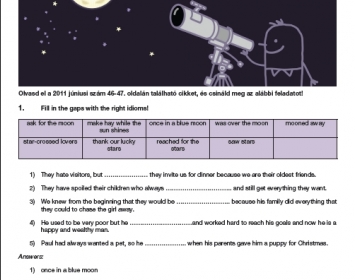49 éve nem látott "eperhold" jelenséget láthatunk ma az égen. Ha lemaradsz, 46 év múlva jön a következő :)
It actually has nothing to do with its colour or how sweet it will look, but when the full moon rises in the sky on Monday, stargazers will be looking at a celestial object known as the “strawberry moon.”
That’s the nickname given to the full moon in the month of June, which this year happens to coincide with the official start of summer. Known as the summer solstice, it will be the longest day of sunlight in the United States and other places in the northern hemisphere.
On the southern side of the globe, June 20 will be the shortest day of the year, so it’s their winter solstice.
A full moon takes place when the moon and the Earth are located on opposite sides of the Sun. At this time, the moon, earth, and sun are aligned in a straight line. A full moon is a lunar phase, in which the illuminated side of the moon faces the Earth and humans see the lighted side of the moon.
So, why is the June full moon called the strawberry moon?
Native tribes that settled in what is now the United States created nicknames for each month’s full moon to help them keep track of the seasons, according to the Farmer’s Almanac. For June, the tribes referred to the full moon as the strawberry moon because June was the prime month for strawberries to be harvested.
Some folks, however, have a different nickname for the June full moon. In Europe, it’s referred to as the “rose moon,” and some cultures call it the “hot moon” because it usually arrives when the heat of summer starts getting intense.
Others, have nicknamed the June full moon the “honey moon,” because this is the most popular month for weddings.
But for most people in modern America, the June full moon is nothing more than an ordinary full moon. If the skies are clear on June 20, the moon will appear to be yellowish or golden orange when it’s close to the horizon and white when it’s high in the sky — not tinted in a strawberry hue.
One sky-watching note: The moon will be completely full on the East Coast at 7:02 a.m. Monday (01:02 pm CEST) but we’ll have to wait for nightfall to get a good view. The moon will be nearly full on June 19 and June 21, so if the skies are clear on those nights, those are the next best options.
As we drift asleep tonight
Under the stars twinkling bright
Caressed by the moon light
May our dreams take flight
source: nj.com
Name of the full moon in the other months:
January |
Wolf Moon because in winter wolf packs howled hungrily outside Indian villages. |
February |
Snow Moon because the heaviest snows fell in this month. |
March |
Worm Moon In this month the ground softens and the earthworm casts reappear, inviting the return of the robins. |
April |
Pink Moon because of the kind of grass that is called pink or wild ground phlox and is one of the earliest, widespread flowers of the spring. |
May |
Flower Moon because flowers are abundant everywhere this time of year. Another name for it is Blue Moon. |
July |
Buck Moon because it’s the time when the new antlers of buck deer push out from their foreheads in coatings of velvety fur. |
August |
Red Moon because the moon rises looking reddish through sultry haze. |
September |
Harvest Moon because at the peak of the harvest, farmers can work into the night by the light of this moon. |
October |
Hunter’s Moon because with the leaves falling and the deer fattened, it is time to hunt. |
November |
Beaver Moon because it’s time to set beaver traps before the swamps freeze to ensure a supply of warm winter furs. |
December |
Cold Moon because In this month the winter cold tightens its grip, and the nights are at their longest and darkest. |
Vocabulary
|
it has nothing to do with sg |
semmi köze valamihez |
|
full moon |
telihold |
|
stargazer |
az eget kémlelő, kutató |
|
celestial object |
égitest |
|
nickname |
becenév, elnevezés |
|
to coincide with |
egybeesik valamivel |
|
solstice |
napforduló |
|
hemisphere |
félteke |
|
globe |
földgolyó, földgömb |
|
to be aligned |
egy vonalba esik |
|
lunar phase |
holdállás |
|
illuminated |
megvilágított |
|
to keep track of sg |
számon tartani, nyomon követni |
|
prime |
fő, legjobb |
|
to harvest |
leszedni |
|
wedding |
esküvő |
|
nothing more than |
nem több valaminél |
|
horizon |
horizont, látóhatár |
|
tinted |
színezett |
|
hue |
árnyalat |
|
CEST/Central European Summer Time |
Közép-Európai nyári időszámítás |
|
nightfall |
alkonyat |
|
to drift asleep |
álomba merülni |
|
twinkling |
ragyogó, csillogó, tündöklő |
|
to caress |
simogatni |
|
wolf |
farkas |
|
earthworm |
földigiliszta |
|
robin |
vörösbegy |
|
phlox |
lángvirág |
|
abundant |
bőséges |
|
antler |
agancs |
|
buck |
őzbak |
|
velvety |
bársonyos |
|
sultry |
rekkenő, perzselő |
|
haze |
köd, pára |
|
fattened |
meghízott |
|
beaver |
hód |
|
trap |
csapda |
|
swamp |
mocsár |
|
to tighten its grip |
bekeményít |





